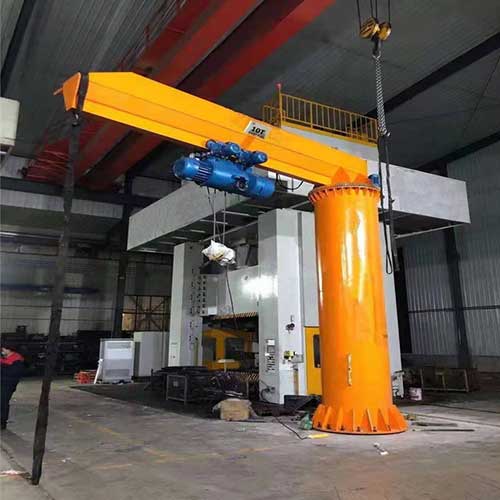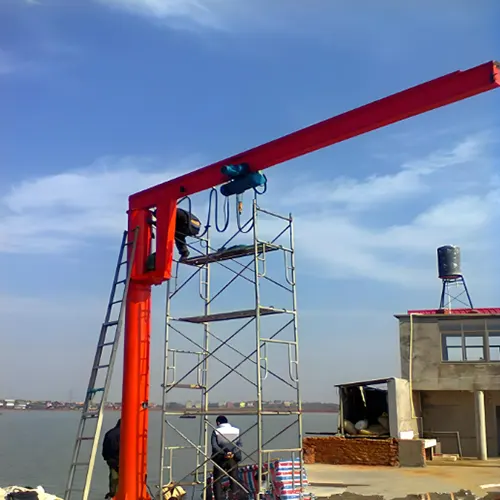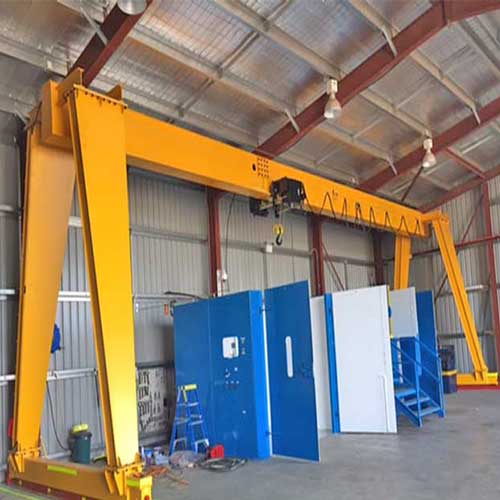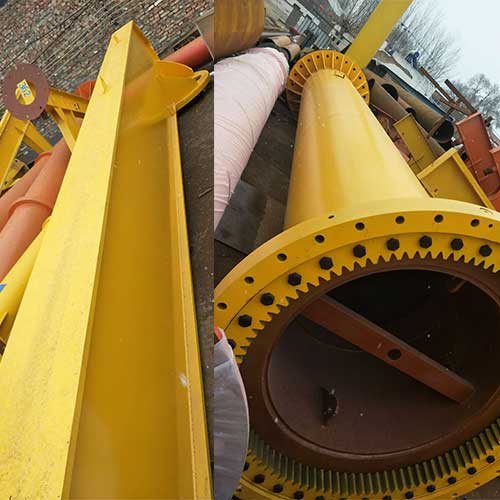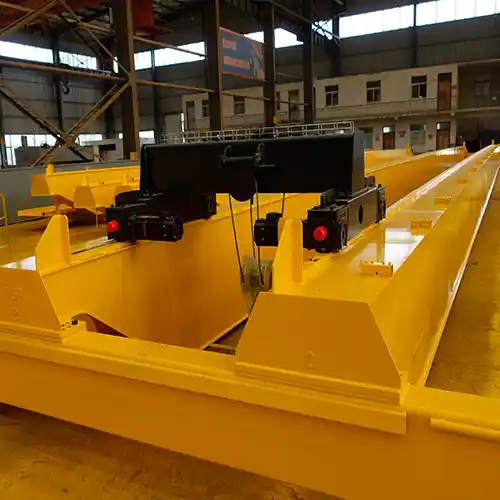Your Trusted Overhead Crane Manufacturer & Supplier
Floor Mounted Crane Designs: Floor Jib, Gantry & Bridge Cranes
Floor Mounted Crane & Floor Mounted Hoist for Sale at Cost-effective Crane Price & Hoist Rate
Floor mounted crane & Floor Mounted Hoist for sale, ie. types of floor jib cranes, floor mounted rail travelling gantry crane & floor mounted freestanding bridge cranes, etc. Contact us to get your customized floor mounted cranes at cost-effective price.
Floor-mounted cranes are the epitome of adaptability. They seamlessly integrate into various industries and applications, offering a tailor-made solution for your lifting needs. Whether you're in manufacturing, warehousing, construction, or any other sector that requires lifting and moving heavy loads, these cranes become your reliable partner in optimizing productivity.
One of the standout advantages of floor-mounted cranes is their ability to make the most of your available floor space. By eliminating the need for intrusive overhead support structures, you unlock valuable space that can be better utilized for your core operations. This is particularly beneficial for compact workspaces or environments where the freedom to rearrange layouts is essential.
But it's not just about space; it's also about performance. The horizontal bridge, complemented by a dynamic trolley and hoist system, grants you exceptional control over load movement. The result? Improved efficiency in assembly lines, streamlined material handling, and precise positioning of heavy machinery – elements that directly impact your bottom line.
Floor mounted jib cranes
Floor-mounted cranes, also known as floor-mounted jib cranes or free-standing jib cranes, are lifting devices used to move heavy objects within a limited area. They are designed to provide a versatile and efficient solution for material handling and lifting tasks in industrial settings, warehouses, workshops, and other locations where there is a need to move loads horizontally and vertically.

Pillar-Mounted (Freestanding) Jib Cranes:
- Features: 360-degree rotation, heavy-duty construction, adjustable height, various hoist and trolley options.
- Benefits: Offers full circular coverage, can be positioned close to walls, provides maximum lifting capacity for the footprint.
- Typical Applications: Manufacturing, assembly lines, material handling in small to medium-sized spaces.
- Tailored Features: Customized heights, boom lengths, and lifting capacities based on specific requirements.

Articulating Jib Cranes:
- Features: Articulating arm design, allows precise load positioning, can reach into tight spaces, 180-degree rotation.
- Benefits: Ideal for tasks requiring flexibility and precision, reduces strain on operators, adapts to obstacles.
- Typical Applications: Machine shops, maintenance areas, workstations with limited space.
- Tailored Features: Articulation range, custom boom lengths, specialized tooling attachments.
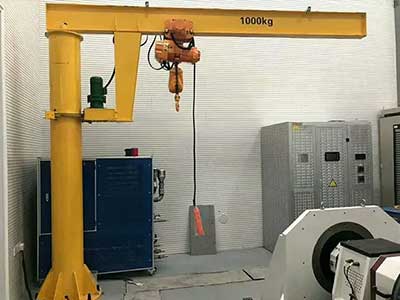
Low-Profile Jib Cranes:
- Features: Shorter jib arm, optimized for low ceiling heights, 180-degree rotation.
- Benefits: Ideal for areas with limited vertical clearance, still provides efficient material handling in confined spaces.
- Typical Applications: Workstations with low ceilings, small workshops, maintenance areas.
- Tailored Features: Custom boom lengths to accommodate restricted overhead space.
Each type of floor-mounted jib crane serves specific purposes, and the choice depends on factors such as the intended applications, available space, load requirements, and ergonomic considerations. When working with a jib crane manufacturer, you can often tailor features such as the crane's height, boom length, load capacity, and even control options to align precisely with your operational needs. This customization ensures that the crane seamlessly integrates into your workspace and enhances your material handling efficiency.
Key features of floor-mounted cranes include:
- Standalone Structure: Floor-mounted cranes are self-supporting structures that are anchored to the floor, hence the name. They do not require additional support from walls or building structures.
- Jib Arm: The crane consists of a vertical mast or post and a horizontal jib arm that extends out from the mast. The jib arm can rotate 180 degrees or more, allowing for a wide range of movement and coverage.
- Load Capacity: These cranes come in various load capacities, ranging from a few hundred pounds to several tons, depending on the model and design.
- Lifting Mechanism: A hoist or lifting device is mounted on the jib arm, which can be operated manually, electrically, or hydraulically. This mechanism enables the crane to lift and move loads vertically.
- Slewing Ability: The jib arm can rotate, or "slew," horizontally around the mast, providing the ability to reach different points within its working area without repositioning the entire crane.
- Compact Design: Floor-mounted cranes are particularly useful in areas with limited space where traditional overhead cranes might not be feasible due to structural or spatial constraints.
- Flexibility: These cranes are versatile and can be used for a variety of tasks, such as loading and unloading trucks, moving heavy machinery, assembling components, and more.
- 8. Safety Features: Modern floor-mounted cranes are equipped with safety features such as limit switches to prevent over-travel, emergency stop buttons, and various locking mechanisms to ensure safe operation.
Floor-mounted cranes offer several advantages, including cost-effectiveness, ease of installation, and the ability to be relocated if needed. They are suitable for industries that require efficient material handling while maximizing the use of available floor space. It's important to choose the right type of floor-mounted crane based on the load requirements and specific operational needs of the facility.
Comparison of floor mounted jib crane vs wall mounted jib cranes

Floor-Mounted Jib Cranes:
- Installation: Floor-mounted jib cranes are directly anchored to the floor, providing stability and load-bearing capacity.
- Rotation: These cranes can offer full 360-degree rotation, providing versatile coverage in the designated area.
- Space Utilization: They require a portion of the floor space for their base, potentially impacting available workspace.
- Flexibility: Floor-mounted jib cranes are flexible in terms of load positioning and can reach areas within their radius.
- Load Capacity: Depending on the type and design, floor-mounted jib cranes can handle a range of loads.
- Applications: Suitable for various applications including manufacturing, assembly lines, maintenance, and material handling.

- Installation: Wall-mounted jib cranes are attached to a wall or column, conserving floor space and leaving it free for other activities.
- Rotation: These cranes offer 180-degree or 360-degree rotation within the area defined by the wall.
- Space Utilization: They maximize floor space as they don't require a base on the floor.
- Flexibility: Wall-mounted jib cranes are fixed to the wall, limiting their ability to reach certain areas.
- Load Capacity: They typically handle lighter loads compared to floor-mounted jib cranes due to their mounting style.
- Applications: Ideal for workstations where floor space is a concern, and where load movement within a specific radius is sufficient.
Comparison:
- Space Utilization: Wall-mounted jib cranes are excellent space-savers, making them suitable for operations with limited floor space. Floor-mounted cranes, on the other hand, occupy some floor space but offer more flexibility in reaching different areas.
- Rotation: Floor-mounted cranes generally offer full 360-degree rotation, allowing them to cover a larger area compared to wall-mounted cranes.
- Load Capacity: Floor-mounted cranes often have higher load capacities due to their construction and direct connection to the floor. Wall-mounted cranes are designed for lighter loads.
- Flexibility: Floor-mounted cranes provide more flexibility in load positioning and reach. Wall-mounted cranes have limitations in terms of their reach due to their attachment to a wall.
- Applications: The choice between the two depends on factors such as available space, load requirements, and the need for maneuverability within the workspace.
Ultimately, the decision between floor-mounted and wall-mounted jib cranes depends on your specific operational needs, spatial constraints, and the type of loads you'll be handling. Consulting with a crane manufacturer or expert can help you determine the best option for your unique situation.
Floor mounted gantry cranes
A floor-mounted gantry crane, also known simply as a gantry crane, is a type of lifting equipment that utilizes a horizontal beam (known as a "gantry") supported by vertical legs to lift and move heavy loads within a defined area. Gantry cranes are widely used in various industrial settings, construction sites, shipyards, warehouses, and other locations where heavy objects need to be lifted, transported, and positioned.
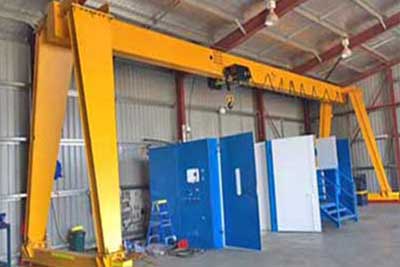
Single Girder Gantry Cranes with Single Leg or Double Legs Design :
- Structure: These cranes have one horizontal girder that supports the lifting mechanism and trolley.
- Advantages: Cost-effective, lightweight design, suitable for light to moderate lifting capacities.
- Applications: Manufacturing, workshops, warehouses, and assembly lines.
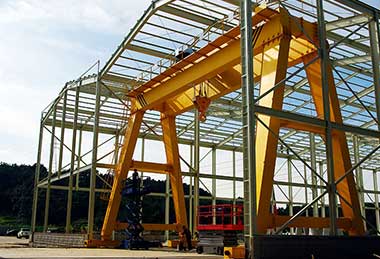
Double Girder Gantry Cranes with SIngle Leg or Double Legs Design :
- Structure: These cranes have two horizontal girders that provide increased lifting capacity and stability.
- Advantages: Higher lifting capacity, suitable for heavier loads and demanding applications.
- Applications: Heavy manufacturing, construction, shipyards, and industries requiring precise load control.
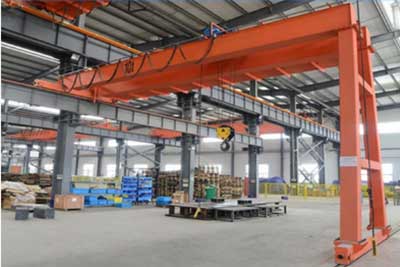
Semi-Gantry Cranes:
- Structure: One end is supported by a building structure or wall, while the other runs on a runway beam.
- Advantages: Combines features of both gantry and overhead cranes, efficient use of space.
- Applications: Work areas with limited space, loading docks, facilities with uneven ground.
Key features of floor-mounted gantry cranes include:
- Gantry Structure: The main feature of a gantry crane is the gantry itself, which consists of a horizontal beam supported by two or more vertical legs. The legs are typically equipped with wheels or casters that allow the crane to be moved along a set path on the ground.
- Lifting Mechanism: A hoist or lifting device is mounted on the gantry beam, which can move along the length of the beam to lift and lower loads vertically. The lifting mechanism can be operated manually, electrically, or hydraulically.
- Load Capacity: Gantry cranes come in a wide range of load capacities, from a few hundred pounds to several tons, depending on the design and configuration.
- Mobility: The wheels or casters on the legs of the gantry crane enable it to be moved horizontally along the ground, allowing for flexibility in positioning the crane where it's needed.
- Span: The distance between the vertical legs determines the span of the gantry crane. Gantry cranes can be designed with different spans to accommodate various load sizes and operational requirements.
- Versatility: Gantry cranes are versatile and can be used for tasks such as loading and unloading cargo from trucks, moving heavy machinery, assembling large components, and more.
- Outdoor and Indoor Use: Gantry cranes can be used both outdoors and indoors, depending on the specific design and requirements. Outdoor gantry cranes are often used in applications like shipyards and construction sites.
- 8. Safety Features: Like other lifting equipment, gantry cranes are equipped with safety features such as limit switches, emergency stop buttons, overload protection, and locking mechanisms to ensure safe operation.
Gantry cranes offer several advantages, including their mobility, relatively quick setup, and ability to handle heavy loads in areas where other types of cranes might not be suitable due to space limitations or infrastructure constraints. They are a cost-effective solution for many lifting and material handling tasks.
It's important to select the appropriate gantry crane based on factors such as the required load capacity, span, operational environment, and safety considerations. Proper training and adherence to safety guidelines are essential when operating gantry cranes to prevent accidents and ensure efficient material handling.
Comparison of floor mounted rail travelling gantry cranes vs roller travelling gantry cranes
Comparing floor-mounted rail traveling gantry cranes and roller traveling gantry cranes involves understanding their differences in terms of movement, support, and applications. Here's a comparison between the two:
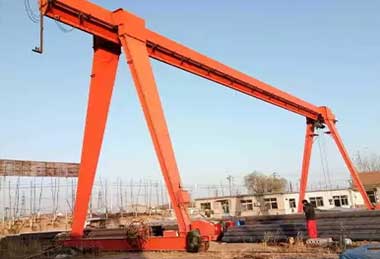
Floor-Mounted Rail Traveling Gantry Cranes:
- Movement: These gantry cranes move along a set of rails or tracks embedded in the floor. They provide precise and controlled movement along a fixed path.
- Support: They are supported by rails that are firmly anchored to the floor. The rails guide and support the crane's movement, ensuring stability and accuracy.
- Advantages:
- Controlled movement along a predetermined path.
- High precision and accuracy in positioning.
- Well-suited for applications requiring repetitive and precise movements.
- Applications:
- Manufacturing facilities with defined assembly lines.
- Warehouses with consistent storage and retrieval locations.
- Environments where loads need to be moved along a specific path.
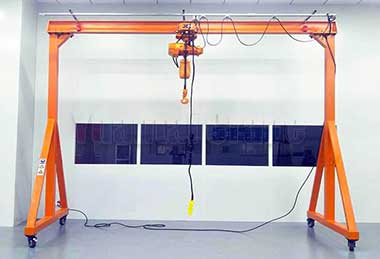
Roller Traveling Gantry Cranes:
- Movement: These gantry cranes move on a set of rollers that run along the floor surface. They provide more flexibility in movement compared to rail-mounted cranes.
- Support: The crane's wheels or rollers come into direct contact with the floor. This allows them to move freely without requiring fixed tracks.
- Advantages:
- Flexible movement in various directions.
- Better adaptability to changing layouts and requirements.
- Suited for applications requiring maneuverability and versatility.
- Applications:
- Warehouses with changing layouts or frequently reconfigured spaces.
- Outdoor yards for loading/unloading trucks and containers.
- Environments where the need for quick changes in movement paths is important.
Comparison:
- Precision vs Flexibility: Rail traveling gantry cranes offer higher precision due to the fixed path of the rails, making them suitable for applications where accuracy is paramount. Roller traveling gantry cranes provide greater flexibility in movement, allowing them to navigate changing layouts or dynamic work environments.
- Stability: Rail-mounted cranes provide stable and controlled movement along the rails. Roller traveling cranes may have some level of play or sway due to the nature of the rolling mechanism.
- Adaptability: Roller traveling cranes are more adaptable to different layouts and can be used in a broader range of applications where movement paths change frequently. Rail traveling cranes are better suited for operations with consistent paths.
- Load Capacity: Both types can handle a range of load capacities, but the choice of crane depends on the specific load requirements and movement patterns.
In summary, the choice between floor-mounted rail traveling gantry cranes and roller traveling gantry cranes depends on factors such as the need for precise movement, adaptability to changing layouts, and the nature of the tasks to be performed. Consulting with a crane expert can help you determine the best fit for your operational needs.
Portable gantry cranes are considered a subset of floor-mounted gantry cranes because they share the characteristic of being supported by a framework that rests directly on the floor. The term "floor-mounted" signifies that the crane's support structure is anchored on the ground, as opposed to being suspended from the ceiling like overhead cranes.
Here's why portable gantry cranes are categorized as floor-mounted gantry cranes:
- Support Structure: Both portable and non-portable (fixed) gantry cranes have legs or columns that rest on the floor to provide stability and support for lifting loads. This is the defining feature of floor-mounted gantry cranes.
- Floor-Bound Movement: Portable gantry cranes can be moved around on their wheels, allowing them to be positioned wherever needed on the floor. Similarly, fixed gantry cranes are anchored to the floor and operate within a designated area.
- Direct Floor Attachment: Both types of gantry cranes have a direct connection to the floor, which ensures stability and allows them to handle a range of lifting tasks.
While portable gantry cranes offer the advantage of mobility, allowing them to be easily transported to different locations, their core structure and method of support still align with the concept of floor-mounted gantry cranes. This is why they are often included in the category of floor-mounted gantry cranes, highlighting their shared characteristic of relying on a floor-based support structure for stability and lifting operations.
Floor mounted bridge cranes / Freestanding bridge cranes
A floor-mounted bridge crane, also known as a free-standing bridge crane, is a type of crane that is constructed on the floor of a facility. It consists of a horizontal bridge, also called a bridge girder, which spans the width of the working area. The bridge is supported by vertical columns or legs that are anchored to the floor. This type of crane allows for both horizontal movement along the bridge and vertical lifting using a hoist and trolley that run along the bridge.
The floor-mounted bridge cranes are often referred to as free-standing bridge cranes or free-standing overhead cranes. The terms "floor-mounted bridge crane," "free-standing bridge crane," and "free-standing overhead crane" are used interchangeably to describe a type of crane that is not attached to the building's structure or walls but is instead supported by its own structure anchored to the floor.
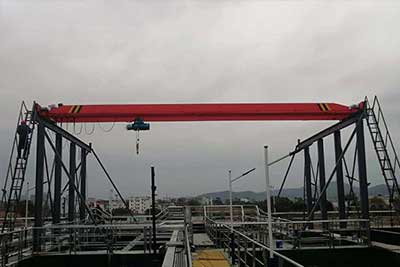
Single Girder Free-Standing Floor Mounted Bridge Cranes:
- Structure: These cranes have a single horizontal girder that spans the distance between the support columns.
- Advantages: Cost-effective, lightweight design, suitable for light to moderate lifting capacities.
- Applications: Manufacturing, assembly lines, warehouses, maintenance tasks.
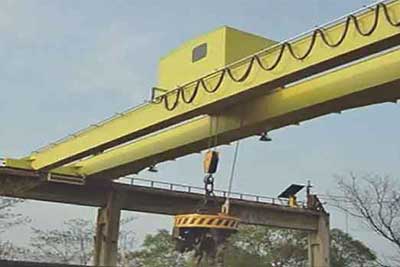
Double Girder Free-Standing Floor Mounted Bridge Cranes:
- Structure: These cranes have two horizontal girders that provide increased lifting capacity and stability.
- Advantages: Higher lifting capacity, suitable for heavier loads and demanding applications.
- Applications: Heavy manufacturing, construction, shipyards, industries requiring precise load control.
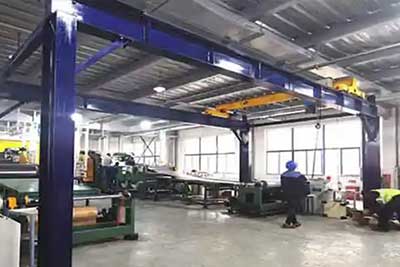
Top Running Free-Standing Floor Mounted Bridge Cranes:
- Travel Mechanism: The crane travels along the top flange of the runway beam.
- Advantages: Maximizes headroom, efficient use of vertical space, and higher lifting capacities.
- Applications: Environments where vertical space is a concern, heavy-duty lifting.
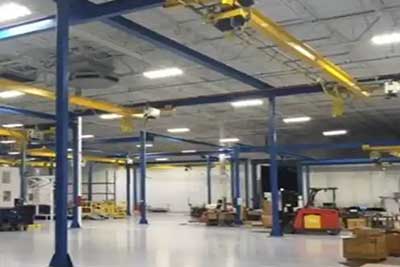
Under Running Free-Standing Floor Mounted Bridge Cranes (Underhung Cranes):
- Travel Mechanism: The crane travels along the bottom flange of the runway beam.
- Advantages: Efficient use of space, well-suited for low headroom situations.
- Applications: Facilities with low ceilings, work areas with limited vertical clearance.
Main featrues of floor mounted bridge cranes
- These cranes consist of a horizontal bridge (bridge girder) that spans the width of the working area and is supported by vertical legs or columns on either side. These columns are firmly anchored to the floor, providing the necessary support for the crane's structure. The crane's trolley and hoist move along the bridge, enabling both horizontal and vertical movement of loads.
- The "free-standing" aspect of these cranes is important because they do not require additional support from building columns or walls, making them suitable for locations where there might not be appropriate structural support available. They are a versatile solution for material handling in various industrial environments.
- These cranes can be single-girder or double-girder configurations, with the latter typically offering higher load capacities and greater stability. They offer benefits such as efficient use of floor space, wide coverage area, and the ability to handle heavy loads with precision.
- "Floor-mounted overhead cranes" seems to be a combination of terms, as overhead cranes are typically attached to the building's structure and do not have their own independent support on the floor. However, I'll address the features of floor-mounted bridge cranes and overhead cranes separately since they are related concepts.
Comparisons of floor mounted bridge cranes vs Standard Overhead bridge cranes
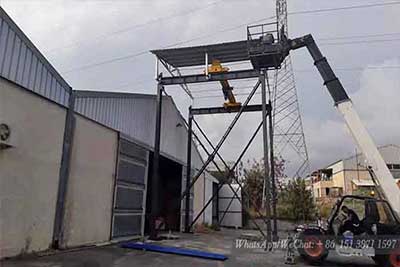
Features of Floor-Mounted Bridge Cranes (Free-Standing Bridge Cranes):
- Independent Support: Floor-mounted bridge cranes have their own support structure consisting of vertical columns anchored to the floor. They do not rely on the building's structure for support.
- Bridge Girder: These cranes feature a horizontal bridge girder that spans the width of the working area. The bridge supports the trolley and hoist, allowing for both horizontal movement and vertical lifting.
- Trolley and Hoist: A trolley is mounted on the bridge, and a hoist is attached to the trolley. This arrangement enables the crane to move loads horizontally along the bridge and to lift and lower loads vertically.
- Wide Coverage Area: The crane's design allows it to cover a large area within the facility, making it suitable for applications that require moving loads across a broad space.
- Load Capacity: Floor-mounted bridge cranes come in various load capacities to suit different lifting needs, from light loads to heavy industrial loads.
- Flexibility: These cranes are versatile and can be used in various industries, including manufacturing, warehouses, and construction sites, for tasks such as material handling, assembly, and loading/unloading.
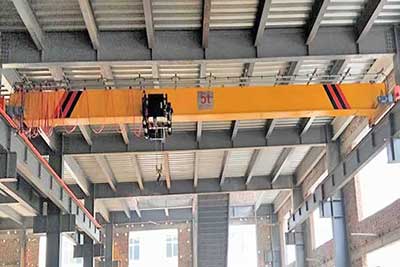
Features of Standard Overhead Cranes:
- Building Attachment: Overhead cranes are attached to the building's structure using rails or tracks that are mounted on columns or the roof. They operate overhead, maximizing vertical space utilization.
- Bridge Movement: The horizontal bridge, supported by the rails, travels along the length of the tracks. This movement provides extensive coverage within the facility without taking up valuable floor space.
- Trolley and Hoist: Similar to floor-mounted bridge cranes, overhead cranes feature a trolley and hoist arrangement on the bridge, allowing for vertical lifting and horizontal movement of loads.
- Load Capacity: Overhead cranes are available in various load capacities, from light-duty applications to heavy industrial operations.
- Precise Positioning: These cranes are capable of precise load positioning due to their overhead design, making them suitable for tasks that require accurate placement of heavy objects.
- Customization: Overhead cranes can be customized to match the specific needs of the facility, including span length, load capacity, and lifting height.
- Variety of Configurations: Overhead cranes can be configured as single-girder or double-girder designs, each offering distinct load-bearing capacities and benefits.
In conclusion, both floor-mounted bridge cranes and overhead cranes offer benefits for material handling tasks, but they have different support structures and operational characteristics. The choice between the two depends on factors such as facility layout, available space, load requirements, and the need for vertical space optimization.
Floor requirements of different types of floor mounted cranes
The floor requirements for different types of floor-mounted cranes, such as floor-mounted jib cranes, floor-mounted gantry cranes, and floor-mounted bridge cranes, can vary based on factors like load capacity, crane design, and intended usage. However, there are some general considerations to keep in mind:
Floor-Mounted Jib Cranes:
- Foundation: Jib cranes require a sturdy foundation to support the crane's column or mast. The foundation should be able to withstand the load capacity of the crane and the forces generated during lifting and movement.
- Floor Flatness: The floor surface where the crane's base will be anchored should be level and flat to ensure proper installation and operation. Uneven or sloping floors can affect crane stability.
- Clearance: Adequate clearance around the jib crane's rotation area is essential to prevent obstructions and ensure safe movement. The surrounding area should be free from obstacles that might interfere with the crane's operation.
Floor-Mounted Gantry Cranes:
- Foundation and Soil: Gantry cranes require a solid foundation capable of supporting the crane's load capacity. The foundation should be designed to distribute the loads evenly across the supporting surface.
- Runway Rails: If the gantry crane moves along runway rails, the rails need to be properly installed on the floor. The floor should be strong enough to bear the load of the rails, the crane, and the loads being lifted.
- Clearance: Adequate space should be available for the gantry crane to move along its path without obstruction. This includes clearance at the ends of the gantry's travel path.
Floor-Mounted Bridge Cranes:
- Runway Rails: Similar to gantry cranes, bridge cranes move along runway rails. The floor should be able to support the weight of the crane, the load, and the runway rails. The runway rails need to be anchored securely to the floor.
- Bridge Travel Path: Adequate clearance and space are necessary for the bridge crane to travel along its designated path without encountering obstacles.
- Column or Leg Placement: For some bridge crane designs, floor-mounted columns or legs support the bridge structure. These should be positioned on a stable foundation and anchored securely to the floor.
In all cases, it's important to consult the manufacturer's specifications and guidelines for the specific crane you are considering. Engineering expertise is often required to ensure that the floor requirements meet safety standards and the operational demands of the crane. Factors such as the type of floor, load-bearing capacity, soil conditions, and local building codes should all be taken into account during the planning and installation process.
Before installing any floor-mounted crane, it's recommended to engage with a qualified crane manufacturer or engineer to assess the specific requirements of your facility and ensure proper installation for safe and efficient operation.
Common Industrial Applications
In the realm of industrial operations, efficiency and precision reign supreme. When it comes to meeting these demands head-on, floor-mounted cranes emerge as the reliable workhorses that redefine the way tasks are executed. Let's delve into some of the most common industrial domains where these cranes take center stage and elevate operations to new heights.
A. Manufacturing and Production Lines
In the fast-paced world of manufacturing, time is money. This is where floor-mounted cranes step in as instrumental assets. Whether you're fabricating machinery components, assembling intricate parts, or managing the flow of materials, these cranes offer a seamless integration into your production line. Their ability to transport heavy loads across the width of your facility provides unparalleled accessibility, ensuring that each step of your manufacturing process aligns with precision and efficiency.
Imagine the advantage of having a lifting solution that can effortlessly maneuver large components into position, reducing downtime and boosting throughput. Floor-mounted cranes empower your manufacturing endeavors, giving you the competitive edge needed to thrive in a dynamic industry.
B. Material Handling in Warehouses
Warehouses are the heartbeats of logistics and distribution. Here, the optimized movement of goods is paramount to success. Floor-mounted cranes find their natural fit in this environment, transforming the way materials are handled and distributed. Whether it's loading and unloading cargo from trucks, stacking inventory, or relocating heavy items within the warehouse, these cranes streamline the entire process.
Their versatility extends to the varied load capacities needed in a bustling warehouse. From the heavier loads to the more delicate shipments, floor-mounted cranes offer the adaptability required to navigate the diverse demands of warehousing. This translates to shorter lead times, reduced operational costs, and an overall enhancement in supply chain efficiency.
C. Automotive Assembly Plants
In the realm of automotive manufacturing, precision and safety are paramount. The intricate processes involved in assembling vehicles demand a lifting solution that not only meets the technical requirements but also ensures the well-being of the workforce. Floor-mounted cranes excel in this arena, offering an optimal balance between performance and safety.
From engine blocks to chassis components, the seamless movement and positioning of heavy vehicle parts are made possible by these cranes. They significantly contribute to streamlining automotive assembly processes, reducing the risk of errors, and maintaining stringent quality standards.
As we journey through these industrial applications, it becomes clear that floor-mounted cranes are more than just lifting solutions – they are enablers of progress, efficiency, and safety. At our crane factory, we understand the unique demands of each industry, and our range of floor-mounted cranes is designed to meet and exceed those demands. In the next segment, we'll unravel the top concerns users might have when considering these cranes and provide comprehensive insights to address them effectively.
Addressing User Concerns
At our crane factory, we understand that making decisions about critical equipment involves careful consideration and a deep understanding of your operational needs. In this segment, we'll delve into some of the key concerns that users often raise when considering floor-mounted cranes. Rest assured, we're here to provide you with comprehensive insights and solutions that instill confidence in your choice.
A. Safety Measures and Compliance
Safety is the cornerstone of any successful operation, and we take this aspect seriously. Our floor-mounted cranes are engineered with an array of safety features that prioritize the well-being of your workforce and the integrity of your assets. From limit switches that prevent over-travel to emergency stop buttons that halt operations in critical situations, we've meticulously integrated safety mechanisms that adhere to industry standards.
Moreover, our cranes are designed to facilitate compliance with relevant safety regulations, ensuring that your operations remain in alignment with best practices. When you choose our crane factory's floor-mounted cranes, you're choosing a solution that not only elevates efficiency but also safeguards your most valuable assets – your people.
B. Maintenance and Longevity
We recognize that your investment extends beyond the initial acquisition. The longevity and performance of your equipment are paramount. That's why our floor-mounted cranes are not only built for strength and durability but are also designed with ease of maintenance in mind.
Regular maintenance is essential to ensure that your crane operates at its peak performance throughout its lifespan. Our expert team is ready to provide guidance on maintenance schedules and practices that will extend the life of your crane and minimize downtime. With the right care, your floor-mounted crane will be a reliable partner in your operations for years to come.
C. Optimal Sizing for Your Operations
Selecting the right crane size is a pivotal decision that directly influences your efficiency and productivity. Our dedicated team of experts is equipped with the knowledge and experience to guide you through this process. By understanding your specific operational requirements, load capacities, and spatial constraints, we'll recommend the optimal crane size that perfectly aligns with your needs.
With our tailored approach, you can be confident that you're investing in a solution that not only meets but exceeds your expectations. Our commitment to your success is unwavering, and we're here to ensure that your floor-mounted crane enhances your operations to their fullest potential.
As we address these concerns, we invite you to reach out to our team for personalized consultations and solutions that cater to your unique requirements. Our next segment will delve into a series of frequently asked questions about floor-mounted cranes, demystifying their capabilities and benefits.
Q&A Section: Floor-Mounted Cranes Explained
As your trusted partner in material handling solutions, we understand that you might have a range of questions about floor-mounted cranes. In this comprehensive Q&A session, we're here to provide you with clear and concise answers that empower you to make informed decisions for your operations.
A. What distinguishes floor-mounted cranes from other types?
Floor-mounted cranes, also known as free-standing cranes, stand independently on their own support structure anchored to the floor. Unlike overhead cranes that rely on building structures for support, floor-mounted cranes offer a flexible solution that maximizes floor space utilization and adapts seamlessly to various industries.
B. How do I choose between single and double girder cranes?
The choice between single and double girder cranes depends on factors like load capacity and space requirements. Single girder cranes are ideal for light to medium-duty tasks and offer cost-effective solutions. Double girder cranes are suited for heavier loads, provide greater lifting heights, and are preferred for demanding industrial applications.
C. Are floor-mounted cranes suitable for outdoor use?
Absolutely! Our floor-mounted cranes can be engineered for both indoor and outdoor applications. They are designed to withstand the elements while maintaining their performance and safety standards. Whether in shipyards, construction sites, or other outdoor environments, our cranes are up to the task.
D. What safety features do your cranes come with?
Safety is a paramount concern, and our cranes are equipped with an array of safety features. These include limit switches to prevent over-travel, emergency stop buttons for immediate halting of operations, and overload protection mechanisms. Rest assured, our cranes are designed to exceed safety standards and promote a secure work environment.
E. How do floor-mounted cranes enhance operational efficiency?
Floor-mounted cranes offer unrestricted movement, allowing precise load positioning and streamlined material handling. With their extensive coverage and versatility, these cranes reduce downtime, enhance workflow, and optimize space utilization. This translates to increased productivity and a more efficient operational ecosystem.
F. Can these cranes be customized for unique requirements?
Absolutely. Our commitment to meeting your specific needs extends to customization. Whether it's adapting load capacities, bridge spans, or other crane specifications, we collaborate with you to create a tailored solution that seamlessly integrates into your operations.
G. What is the recommended maintenance routine for these cranes?
Regular maintenance is essential for crane longevity and performance. We recommend a routine maintenance schedule that includes visual inspections, lubrication, and addressing wear and tear. Our team of experts is here to guide you through maintenance best practices, ensuring your crane operates at its peak potential for years to come.
As you contemplate integrating our floor-mounted cranes into your operations, know that our expertise and dedication are at your disposal. Stay tuned for the concluding chapter of this series, where we highlight how partnering with our crane factory transforms your material handling endeavors.
Partnering with Us for Your Lifting Needs: Tailored Floor Mounted Cranes
As you embark on your journey to enhance your material handling capabilities, the importance of selecting the right partner cannot be overstated. At our crane factory, we stand as your dedicated ally, ready to elevate your operations with our range of innovative and meticulously designed floor-mounted cranes. Here's why you can trust us to be your go-to source for tailored lifting solutions.
A. Trusted Manufacturer and Supplier
With a track record of excellence and a reputation built on quality, we've earned the trust of industries far and wide. Our commitment to engineering excellence and unwavering dedication to delivering reliable solutions have positioned us as a trusted manufacturer and supplier in the field of material handling. When you choose our crane factory, you're choosing a partner that takes pride in its craftsmanship and prioritizes your success.
B. Dedicated to Providing Tailored Solutions
We understand that every operation is unique, and the challenges you face require solutions that align perfectly with your needs. That's where our commitment to providing tailored solutions comes into play. Our team of experts collaborates closely with you to understand the intricacies of your requirements. From load capacities to space constraints, we tailor our floor-mounted cranes to ensure optimal performance within your specific environment.
No challenge is too complex for us to address. Whether you're navigating limited floor space or working with intricate load dimensions, we rise to the occasion to craft a solution that seamlessly integrates into your operations.
Your Trusted Floor Mounted Crane Manufacturer & Supplier
